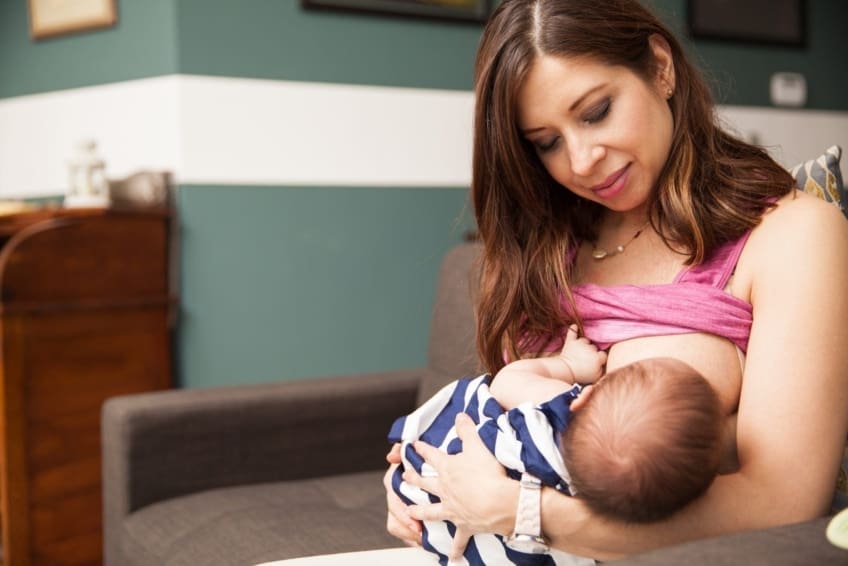
What is mastitis?
Mastitis is an inflammation of the breast. It is usually caused by an infection. It often happens while a woman is breastfeeding, especially during the first 6-12 weeks. Having mastitis does not raise your risk of developing breast cancer.
What are the symptoms of mastitis?
Women who have mastitis may feel ill. They may feel run down or achy. In addition to an inflamed breast, they may feel like they have the flu. Other symptoms may include:
- Breast pain
- Breast swelling
- A tender, red, wedge-shaped area on the breast
- A breast that is warm or hot to the touch
- A burning sensation while breastfeeding
- Discharge from the nipple
- Fever
- Chills
- Nausea or vomiting
Mastitis usually affects only one breast at a time.
What causes mastitis?
Mastitis is usually caused by germs (bacteria) that are found on the skin or in your baby’s mouth. These bacteria can enter your breast through a milk duct opening or a crack in the nipple.
Infection is more likely to happen when milk is trapped in the breast. Stagnant milk sitting in the breast makes bacteria grow, which leads to infection. Trapped milk can happen due to inexperience or poor technique in breastfeeding. Sometimes a milk duct can get blocked, causing milk to back up in the breast.
You may be at higher risk of developing mastitis if you:
- Have sore or cracked nipples
- Use only one position to breastfeed (using different positions helps make sure you completely drain the breast)
- Wear a tight-fitting bra or put pressure on your breasts (which can restrict milk flow)
How is mastitis diagnosed?
Your doctor will ask you about your symptoms and examine the affected breast. They will check for swelling, tenderness, and a painful, wedge-shaped area on the breast that is a tell-tale sign of mastitis.
If you are not breastfeeding and you have symptoms of mastitis, your doctor may order other tests. These could include a breast ultrasound, MRI, mammogram, or biopsy.
Can mastitis be prevented or avoided?
Below are some basic breastfeeding techniques to lower your risk of developing mastitis.
- Your baby should latch onto the nipple with their mouth open wide.
- Allow your baby to empty one breast before switching to the other breast.
- Change your baby’s position from one feeding to the next to help empty all the areas of the breast.
- If you need to stop a feeding, break the suction using your finger.
- Don’t wear tight-fitting bras or breast pads that cause your nipples to stay moist after breastfeeding.
- Air your nipples out when possible.
- Tell your doctor or lactation consultant if you have nipple pain during nursing.
Mastitis treatment
Sometimes breast infections go away on their own. If you notice you have symptoms of mastitis, try the following:
- Breastfeed on the affected side every 2 hours, or more frequently. This will keep your milk flowing and prevent your breast from getting too full of milk.
- Massage the area. Start behind where it is sore and use a circular motion toward the nipple.
- Apply warm, moist compresses to the sore area.
- Wear a supportive, well-fitting bra. Make sure it isn’t too tight. You don’t want to constrict your milk ducts.
If you don’t start feeling better 24 hours after trying these tips, or if your symptoms are getting worse, call your doctor. You may need medicine.
Your doctor will likely prescribe antibiotics to treat the infection. You should start to feel better a few days after starting the antibiotics. But make sure you take all the antibiotics your doctor prescribes to prevent antibiotic resistance.
Over-the-counter pain medicines such as acetaminophen (brand name: Tylenol) or ibuprofen (brand name: Advil) can help relieve pain. Warm showers can also help relieve the pain.
Although it may be painful, it is important to keep breastfeeding when you have mastitis. Your breast milk will not be bad for your baby, even if you have mastitis, although some infants may not like the taste. If you stop breastfeeding, germs can spread in the milk that is left in your breast. This could make your infection worse. If you cannot nurse your baby, you should pump your breasts to remove the milk.
Getting enough rest and drinking extra fluids can help you feel better faster. Talk to your doctor if your symptoms get worse.
Living with mastitis
If mastitis isn’t treated properly, an abscess (collection of pus) may develop. This could form a mass in your breast. Abscesses are usually painful. They normally must be drained surgically.
Call your doctor right away if you notice any of the following symptoms:
- Infection in both breasts
- Pus or blood in your breastmilk
- Red streaks near the affected area
- Symptoms came on severely and suddenly
- A painful lump that might be an abscess
To prevent these types of complications, call your doctor when you first notice symptoms of mastitis.
Questions to ask your doctor
- What is the likely cause of my mastitis?
- Is my milk still safe for the baby?
- Do I need antibiotics? How should I take them? Are they safe for the baby?
- I’d like someone to observe my breastfeeding technique. Do you have a lactation consultant on staff?
- Where can I find breastfeeding support?
- Is there anything else I should do to help prevent mastitis?
- Does mastitis increase my risk of breast cancer?
Resources
La Leche League International: Mastitis and Sore Breasts
National Institutes of Health, MedlinePlus: Breast infection
![]()
Copyright © American Academy of Family Physicians
This information provides a general overview and may not apply to everyone. Talk to your family doctor to find out if this information applies to you and to get more information on this subject.



